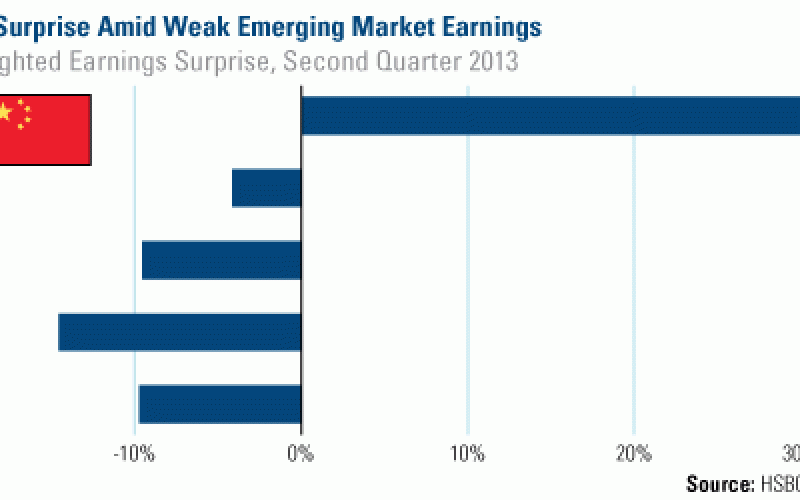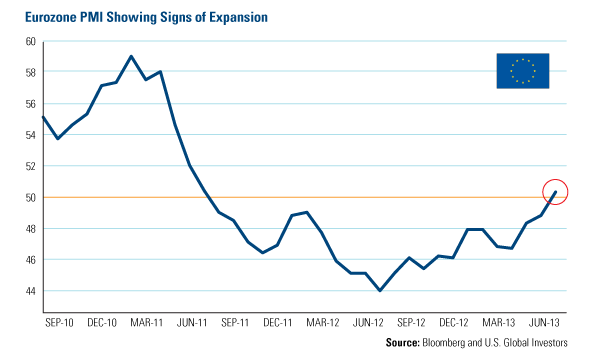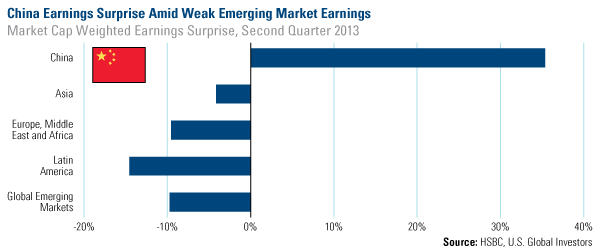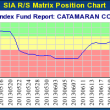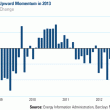Emerging Markets Radar (August 5, 2013)
Strengths
- The Central Politburo of the Communist Party of China (CPC), China’s ruling party, held its meeting this week to support Premier Li Keqiang’s policy to maintain economic growth, restructuring and reform. The Politburo discussed the promotion of healthy and stable developments in the property market, but did not mention curbing housing sales or price control. In the State Council meeting Li Keqiang promoted new urbanization spending plans by focusing on improving urban transit, water and the environment. The People’s Bank of China (PBOC), the central bank, conducted two reverse repos this week by injecting $2.8 billion and $5.55 billion, respectively, demonstrating easing bias in maintaining growth. Also on the policy front, the government ordered the National Audit Committee to audit local government debts in preparation for the Third Plenary Session of the 18th CPC Central Committee. The session will be held in October, where the economic policy will hopefully be discussed.
- China’s official purchasing managers’ index (PMI) for the month of July rose to 50.3 from 50.1 in June. This was better than the market consensus of 49.8. The new orders index increased from 50.4 in June to 50.6 in July, mainly due to a rise in new orders. The employment index also went up from 48.7 in June to 49.1 in July, following a similar increase in small enterprise PMI from 48.9 in June to 49.4 in July. China’s production index grew from 52 in June to 52.4 in July. The purchasing price index jumped from 44.6 in June to 50.1 in July. The purchase index also improved from 49.5 in June to 50 in July. On the other hand, the finished goods inventory index fell from 48.2 in June to 47.3 in July. The reading for the raw materials inventory index edged up from 47.4 in June to 47.6 in July, remaining in contracting territory along with the finished goods inventory index. Continued demand improvement is required for enterprises to add inventory. The indices for new export orders, as well as for imports, improved in July signaling a possible recovery in trade performance. The new export orders index improved from 47.7 in June to 49 in July. China’s import index also improved from 47.9 in June to 48.4 in July. Given the close correlation between these indices and the real export performance, a mild recovery in China’s export performance is expected in the next two to three months.
- Sales growth for China’s healthcare industry was 22 percent year-over-year in May, up from 21 percent in April, and 15 percent in May 2012. Chemical drug sales grew 16 percent, which is higher than the 13 percent growth in April but lower than the 22 percent growth in May 2012. Biotechnology, traditional Chinese medicine (TCM), and device sales growth surged to 33 percent, 30 percent and 25 percent, up from 12 percent, 20 percent and 12 percent, respectively, in May 2012. China’s overall gross margin expanded by 110 basis points to 30.5 percent in May, on better gross margins of chemical drugs, biotech and devices. Operating margin also increased, by 170 basis points to 11.9 percent from 10.2 percent in April. Net margins widened by 110 basis points to 10 percent in May, with higher net margins across all subsectors.
- Korea’s exports increased 2.6 percent in July, surpassing analysts’ expectations of a 2.1 percent increase. The previous reading for June was negative 1.0 percent. Headline inflation rose in July to 1.4 percent year-over-year from 1.0 percent in May and June. On month-over-month terms, headline inflation rose to 0.2 percent from being down 0.10 percent in June. July figures were in line with the market consensus. Core consumer price index (CPI) inflation, excluding agricultural products and oils, rose further by 0.10 percent month-over-month and 1.5 percent year-over-year, from 1.4 percent in June.
- Taiwan’s second-quarter GDP recovered by growing 2.27 percent year-over-year, above the consensus of 2.1 percent. This was due to stronger than expected exports.
- Brazilian inflation slowed to 5.18 percent in July from 6.31 percent in June, showing the monetary tightening process initiated in June is rapidly yielding the desired outcome. A different report showed that industrial production in Latin America’s largest economy rose 3.1 percent in June. The reading was ahead of economists’ forecast of a 2.2 percent increase, a faster pace than the 1.4 increase recorded for the previous month.
- Poland’s PMI rose for the third month in a row as July’s reading reached 51.1 from 49.3 in June. The reading lends support to the central bank’s decision earlier this month to end the easing cycle and adds to the sentiment of the Polish economy bottoming in the first half of the year. Similarly, the Czech manufacturing PMI rose for the fourth month in a row, as July’s reading reached 52, up from June’s reading of 51. This supports the thesis that economic growth in the country is gaining momentum after a very weak first quarter.
Weaknesses
- HSBC reports that Latin American markets are heading into another disappointing earnings quarter. Though it is still early in the second-quarter earnings season, emerging market earnings are down 10 percent compared to analysts’ forecasts. Mexico, who is nearing the end of its reporting period, has so far missed by an average of 20 percent. Brazil, only one-third of the way done at this point, has missed by 10 percent. The only large Latin American market that is currently beating earnings’ forecast is Colombia.
- Turkey’s PMI declined to 49.8 in July from 51.2 in June. The reading is the lowest in a year, boosting speculation that the nation may miss its 2013 growth targets. The impact of a weak Turkish lira added to the volatility surrounding the recent Gezi Park protests. Turkey joins other emerging market nations such as Russia and Hungary, which are showing signs of weakening economic activity.
- China’s government revenue in the first half of the year grew 7.9 percent, 1.9 percent slower than the same period last year. The slower government revenue growth is due to slower economic growth. Per-capita income grew 6.5 percent for the first half of the year, slower than 9.7 percent for the same period last year, and slower than the GDP growth rate, indicating structural weakness in the economy.
- China’s industrial profits in June were 11.1 percent year-to-date, which is the lowest print so far this year.
- Indonesia saw July’s headline inflation rising to 8.61 percent from 5.9 percent, following the fuel price hike in June. This is higher than the consensus of 8.04 percent. The surge in inflation was mainly driven by food, processed food and transportation prices. Indonesia may raise interest rates following the expectation of rising inflation.
Opportunities
- Manufacturing PMI for the eurozone expanded at a faster pace than was estimated for July to 50.3. This was up from 48.8 in June topping the 50-mark for the first time since July 2011. A reading above 50 indicates expansion. Similarly, economic confidence in the region improved to a fifteen-month high. According to Markit economists, rising confidence encourages businesses to invest more, and also encourages consumers to lift their spending. This may place the region nicely, spurring positive third- quarter economic growth and helping the eurozone to exit recession.
- The second quarter reporting period in the global emerging markets space has been challenging. Latin America has posted negative earnings’ surprises, driven by Mexico and Brazil. Asia and the EMEA (Europe, the Middle East and Africa) region have not fared any better. The shining star amid the negativity is China, where the average market capitalization weighted earnings’ surprise is close to 35 percent. Is still early in the reporting cycle, but a continuation of this trend could bode very well for Chinese utilities, information technology, healthcare, consumer discretionary and real estate stocks.
- Despite private equity fundraising declining in 2013, Latin America is capturing a greater share of the market. Of the total emerging market private equity fundraising deployed in the first half of 2013, 23 percent was directed to Latin America. This is up from only 10 percent in 2012. Interestingly, two-thirds of this money was deployed on specific country mandates ex-Brazil. Asia continued to lead, capturing 63 percent of total fundraising.
Threats
- Peter Hooper, chief economist of Deutsche Bank, continues to expect that economic activity and inflation in the U.S. will show enough evidence of improvement to allow the Federal Reserve to move ahead with a tapering in September. At the same time, the tapering will likely be accompanied by an emphasis on keeping rates low for an extended period of time. The bottom line is that the tapering is still on, and despite the dovish signals seeking to reduce volatility, emerging markets will continue to face selling pressure.
- A recent Nielsen study shows that consumer confidence is growing in every region except in Latin America. Within that region it falls in every country, except Colombia. Brazil’s consumer confidence remains the highest, which makes the country more vulnerable given its lower economic growth. On absolute terms, Latin America’s consumer confidence fared significantly better, holding above that of North America, Europe, the Middle East and Africa.
- Thailand’s manufacturing declined 5.2 percent in the second quarter. Imports of capital goods dropped 11.4 percent in June and were down 10.3 percent for the second quarter. Exports in June dropped 2.3 percent. These weak economic indicators point to a de-stocking bias in the country.





